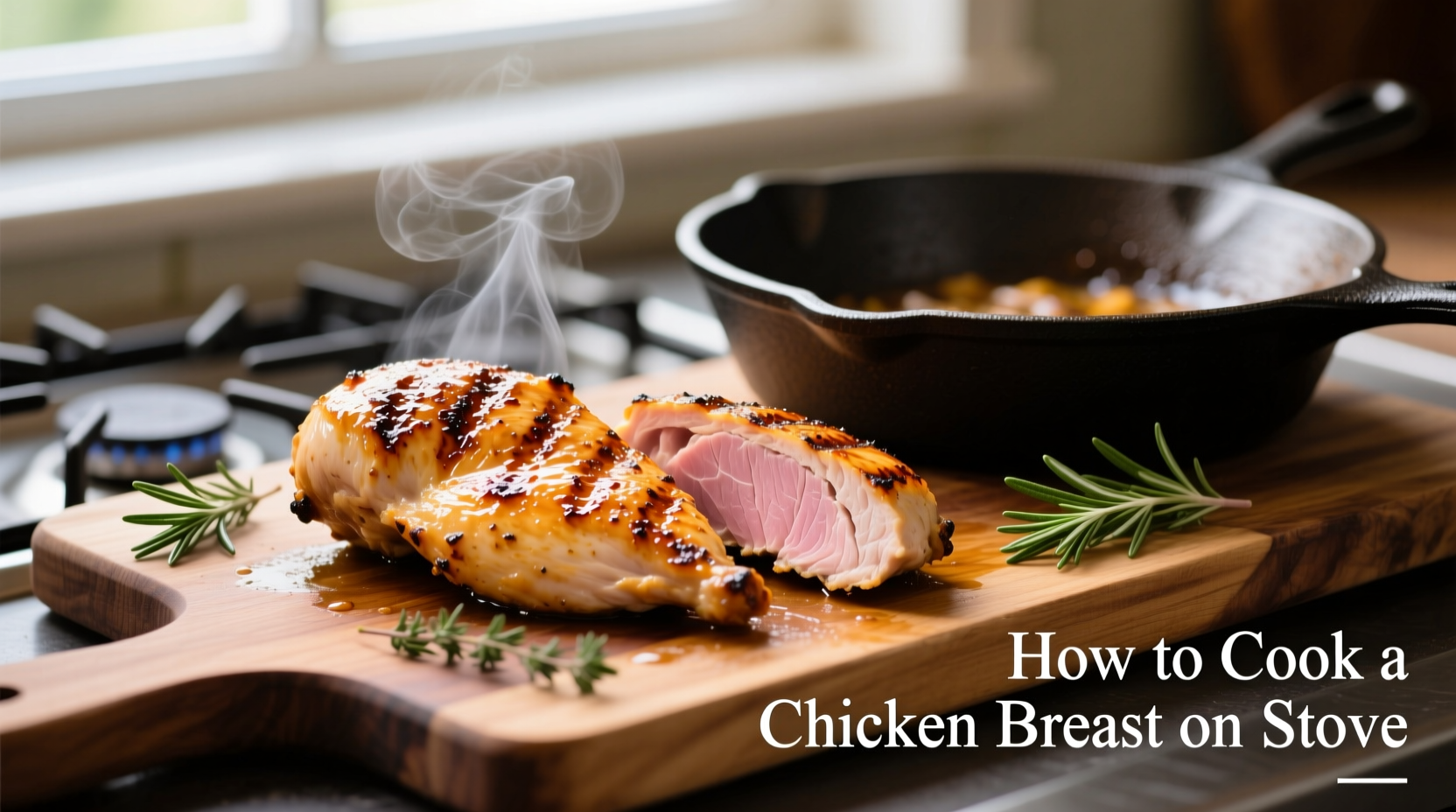Nothing ruins dinner plans faster than dry, rubbery chicken breast. But mastering stove-top cooking transforms this lean protein into a weeknight hero. As a chef who's cooked thousands of chicken breasts in professional kitchens and home stoves, I've refined a simple technique that guarantees restaurant-quality results without fancy tools.
Why Stove-Top Wins for Chicken Breast
While ovens and air fryers have their place, the stove offers unmatched control for thin cuts like chicken breast. You can visually monitor the sear, adjust heat instantly, and create flavorful pan sauces in the same vessel. According to USDA Food Safety and Inspection Service guidelines, chicken must reach 165°F (73.8°C) internally, but pulling it at 160°F allows carryover cooking while preventing dryness—a precision only possible with direct-heat methods.
| Cooking Method | Best For | Common Pitfall |
|---|---|---|
| Stove-Top Skillet | Thin cuts (½"-1" thick) | Overcrowding pan causing steaming |
| Oven Roasting | Thicker cuts or multiple pieces | Dry edges before center cooks |
| Poaching | Shredded chicken applications | Bland flavor without proper seasoning |
Prep Like a Pro: The 5-Minute Foundation
Skipping proper preparation causes 90% of cooking failures. Follow these critical steps before touching heat:
- Dry thoroughly—Moisture creates steam instead of sear. Pat with paper towels until no residue transfers
- Uniform thickness—Place plastic wrap over breast and gently pound thicker end to ¾" evenness
- Strategic seasoning—Salt at least 15 minutes pre-cooking (or up to 24 hours) for deeper flavor penetration
- Room temperature start—Remove from fridge 20 minutes before cooking for even heat distribution
The Golden Rule Cooking Sequence
This 8-minute cooking process works for standard 6-8oz chicken breasts. Adjust times proportionally for larger cuts:
- Heat 1 tbsp high-smoke point oil (avocado or grapeseed) in heavy skillet over medium-high heat for 2 minutes
- Test oil readiness—oil should shimmer but not smoke; a breadcrumb sizzles immediately
- Place chicken in pan away from you to prevent oil splatter
- Cook undisturbed for 5-6 minutes until deep golden brown and releases naturally from pan
- Flip and cook 4-5 minutes until internal temperature reaches 160°F at thickest part
- Rest 5 minutes tented with foil—temperature will rise to safe 165°F while juices redistribute

Troubleshooting Real Kitchen Problems
Even with perfect technique, variables happen. Here's how to handle common issues:
"My chicken sticks to the pan!"
This indicates insufficient preheating or premature flipping. Wait until the chicken naturally releases—forcing it causes tearing. Next time, ensure oil is properly heated and chicken is thoroughly dry.
"The outside burns before inside cooks"
Reduce heat to medium after initial sear. For thicker breasts, finish in 375°F oven for 3-4 minutes. Always use instant-read thermometer—visual cues alone are unreliable.
"How do I add flavor without drying it out?"
Create pan sauce after removing chicken: Deglaze with ¼ cup broth, add 1 tbsp cold butter, and fresh herbs. Never add acidic ingredients (lemon, vinegar) during cooking—they accelerate protein tightening.
When Stove-Top Isn't Ideal: Context Boundaries
While versatile, stove-top has limitations. Avoid this method when:
- Cooking more than 2 breasts at once (causes overcrowding and steaming)
- Using extremely thin cutlets (try pan-frying in egg wash instead)
- Need hands-off cooking (oven roasting better for meal prep)
For best results, match cooking method to your specific scenario. The stove shines for quick weeknight dinners with one or two portions where you want maximum browning and pan sauce potential.
Safety First: USDA Verified Temperatures
Food safety isn't negotiable. The USDA Food Safety and Inspection Service confirms all poultry must reach 165°F internal temperature. However, professional kitchens use the carryover cooking principle:
- Remove chicken at 160°F
- Rest 5 minutes covered
- Final temperature reaches 165°F while retaining moisture
This technique prevents the dryness that occurs when cooking straight to 165°F. Always verify with an instant-read thermometer inserted horizontally into the thickest part.
3 Flavor Variations Ready in Minutes
Transform basic chicken with these chef-approved finishing touches:
- Lemon-Herb: After resting, top with 1 tbsp lemon juice, 1 tsp fresh thyme, and lemon zest
- Garlic Butter: During last minute of cooking, add 2 smashed garlic cloves and 1 tbsp cold butter to pan
- Spiced Crust: Mix ½ tsp paprika + ¼ tsp garlic powder with salt before cooking for subtle smokiness
Remember: Never apply delicate herbs (basil, parsley) before cooking—they burn. Add fresh herbs after resting for maximum flavor impact.
Mastering the Basics Builds Confidence
Perfect stove-top chicken breast unlocks countless meal possibilities. Once you've nailed this fundamental technique, you'll approach other proteins with newfound confidence. The key is respecting the process—proper prep, controlled heat, and accurate temperature monitoring—rather than rushing for instant results. In my decade of teaching home cooks, those who master this simple method consistently create restaurant-worthy meals with minimal equipment.











 浙公网安备
33010002000092号
浙公网安备
33010002000092号 浙B2-20120091-4
浙B2-20120091-4